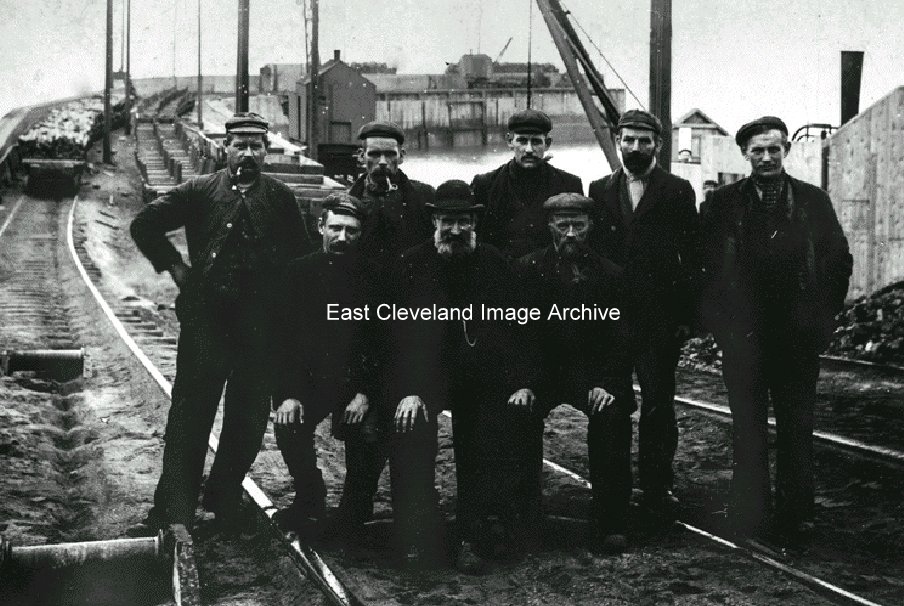
It’s getting a bit repetitious now! Looking towards the loading bay this time we have more of the jetty workforce – can you name them?
|
|
||
|
It’s getting a bit repetitious now! Looking towards the loading bay this time we have more of the jetty workforce – can you name them?
This image of the workforce of the jetty was taken from the Jetty platform looking up the incline towards the engine house. The Archive’s question is: can anybody name them?
This is the image that everybody has seen at some time. Taken half-way up the rope incline from the works it shows two rakes of pig iron bogies, one of the company steam tramps and the dock-side cranes. Taken by George Skilbeck, photographically the incline trackway leads the eye into the image and out through the curve of the jetty, which is probably why it has stood the test of time; it has good artistic composition. Unfortunately this image had been ‘cropped’ before receipt to the Archive and continue to hope for an original undamaged image.
How many people have spent many a happy night fishing off the end of this old structure; passing through a period of looking the worse for wear and lack of maintenance, it is now restored to its former glory. Here it is in it’s heyday, the coffee-pot locomotive steaming away and a rake of pig iron bogies waiting to load. The steam cranes are working on one of the company ships and a good solid industrial image.
Once again the obvious question – can you name these men – with the exception of Jack Harrison? Back Row: ??, ??, John (Jack) Harrison, ??, ??, ??, ??. Front Row: ??, ??, ??, Capt. Fryatt, ??. We are told by David Richardson: ”One of the crew may be Thomas Gifford. His marriage certificate (1899) gives his usual residence as being SS Skinningrove.” Image courtesy of Eric Johnson and thanks to David Richardson for the update.
An extremely clean SS Skinningrove moored at Skinningrove jetty. It was the first of the four steamers owned by The Skinningrove Iron Company; she was employed carrying pig iron to the Company’s customers. Image courtesy of the Cleveland Ironstone Mining Museum.
Skinningrove Iron and Steel Works is a postcard image by George Skilbeck, the view is from Carlin How towards the Talbot’s, the Scottish Agricultural Slag plant is off to the left; you can just see the basic slag heap from the Talbot furnaces. The railway station is in the right foreground with the locomotive water tower just in view and the stockyards are mid-right of the image. David Mills asked: “Hi I wonder if you could help me I’m looking for some information regarding the demolition of the steel plant at Skinningrove in particular which company demolished the plant? My father worked for a company called F. B. Parvin Ltd; I believe it started to be demolished around the end of 1972 into 1973.” Can anybody assist with information? Image courtesy of John G. Hannah and thanks to David Mills for the update.
This looks like a motor-generator unit – looks pretty beefy too – please correct us if we’re wrong! Terry Robinson tells us: ”This is the Blackstone Mirlees emergency generator unit, which is situated opposite the surface engineering building.” Terry also advises: “This is the emergency generator at Boulby mine.” Image courtesy of Alan Franks and thanks to Terry Robinson for the updates.
Eric Johnson featured (at work) in front of the Wash Heater Charger, which forms part of the 36 inch Mill at Skinningrove works. Eric drove; 30 years after driving the chargers on the Talbots. Full circle. Paul Dodsworth told us: “I also drove the mill charger for quite a spell taking over from Bill Noble of Liverton Mines. I used to follow on the shift pattern from Jerry Jarvis also from Liverton Mines.” Image courtesy of Eric Johnson and many thanks to Paul Dodsworth for the update.
Here’s a newspaper cutting showing the top apprentices at Skinningrove in 1976. Martin Smith tells us: ”I am third from right back row. I believe this photo was taken at the end of 1976, because that was the year I won this award.” |
||
Recent Comments